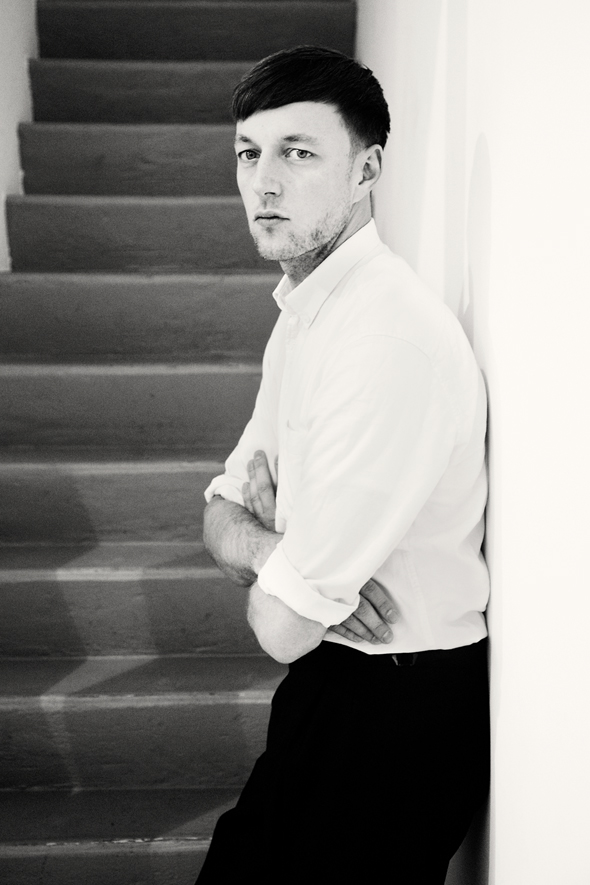
When we meet Cedric Charlier at an elegant cocktail reception in his honor at Barney’s NY in San Francisco’s Union Square, the Belgian designer seems to be having difficulty absorbing his good fortune. As he takes in the sight of his name on the wall, the hanging racks filled with his designs and the assembled socialites happily posing for the event’s photographers, clad in the best pieces from his latest collection, his expression fluctuates from bemused to vaguely shocked.
Perhaps it’s just the jet lag; yesterday, Charlier was at a similar event in New York. Tomorrow he’s off to LA to meet some more of his West Coast fans. But also, Charlier’s ascension from relative unknown to fashion wunderkind happened dizzyingly fast. Following his first eponymous collection in Paris in February 2012, Charlier rapidly garnered an extraordinary amount of media attention as well as an enthusiastic fashionista following. Still, this designer is hardly the new kid in the block. After winning a Moët Hennessey Fashion Award in 1998, Charlier gained experience working at prestigious labels Celine, Lanvin, and most recently, serving as creative director of Cacharel, where he played a major role in turned the formerly saccharine-sweet brand into a fashion heavy hitter. When his contract ended, the time finally seemed right to strike out on his own.
The transition from working for well-known, Parisian brands to coming into his own as an independent Belgian designer has been nothing short of a paradigm shift. The soft-spoken designer explains that being part of the Parisian fashion scene was an ideological challenge for someone as firmly Belgian as he. “In Paris it’s all about ‘fashion’ and established design houses and trends, and whether a look is commercial or editorial enough.” In Belgium, on the other hand, “design itself is the main focus” and hence it is the designers who are idolized in all their uniqueness, their idiosyncrasies celebrated.
Charlier is very much a designer, according to his definition of the term. His success has as much to do with a finely-honed artistic sense as with his mastery of cutting and draping which he inherited from his grandmother, a seamstress who taught him embroidery at a young age. Embroidery is a traditional part of the Belgian heritage and the designer admits that he was as much shaped by the Belgian landscape as by his work experience in Paris. Charlier also reveals the likely source of the artistry that permeates each of his designs: his lifelong passion of painting, one that he has not been able to pursue lately due to the infernal rhythm dictated by the rapid-fire production of four fashion collections.


Though Charlier may not have time for painting per se, he expresses himself through his high-energy prints, all of which are custom produced in-house. In his S/S 2013 collection, Cedric refers to his punchy colorway as “Mercurochrome Monochrome.” Though the name evokes black and red, which are definitely present particularly in the evening wear, there are also ample shocks of fuchsia, tangerine, neon yellow as well as brilliant white. The garments were partially inspired by an exhibit of Samurai armor Charlier explored while traveling in Japan. He likes the idea “of dressing women as modern warriors”: the traditionally rigid armor rendered in fluid, ethereal layers. “Une armure de charme,” says the designer, reverting to his native French as he attempts to explain the idea of a ephemeral yet powerful armor created by a woman’s own unique charm. For the runway, the concept of “woman-as-warrior” was underlined by dramatic makeup; geometric carmine streaks on models’ brows in lieu of helmets and precisely applied black makeup over the entire lower leg, which Charlier likens to “summer boots”— swearing that, thus made up, the models acquired a more determined gait. “It’s a new attitude,” says Charlier. “It’s about spontaneous gestures, the interplay of rigidity and fluidity.” Indeed, the collection successfully marries slightly deconstructed, flowing garments with raw yet precise edges in addition to geometric looks bisected by visible zippers and even a very basic, yet perfectly cut black suit —the working woman’s armor. And still, the collection manages to retain a real cohesion.
When asked about his inspirations other than art and travel, Charlier mentions music and people. “Sometimes a chance meeting can be like a voyage,” he suggests. The important thing is to remain passionate. “Fashion is a part of my life,” he says, “and as long as I’m passionate, I’m alive.”
The interview over, it’s time for Charlier to mingle with his fans, most of whom have not yet noticed that the discreet designer is already in their midst. A society photographer approaches and takes a few photos of interviewer and designer. “Can you spell your name into the camera, please?” asks the photographer, unaware of the fact that he has just shot the guest of honor. The bemused expression returns to Charlier’s face, along with a delighted smile. He points to the wall, where his name is plastered in black letters, gestures to the clothing racks. “That’s me.”
Text by Karena Akhavein

